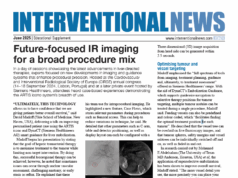
Addressing the audience at the 33rd annual meeting of the Cardiovascular and Interventional Radiological Society of Europe (CIRSE; 22–25 September, Lisbon, Portugal), Sanjiv Sharma asks: “If you can have a drug-eluting stent, why can’t you have a stem cell-eluting stent?” Here, Sharma argues that a paradigm shift in the management of critical limb ischaemia is on the horizon, with stem cell therapies proving safe, effective, and less costly than surgical or endovascular revascularisation.
Management strategies for critical limb ischaemia (CLI) are constantly evolving due to issues and challenges with the image morphologies in below-the-knee vessels and rapidly changing device technologies, mostly with unmet long-term outcome expectations. Many times, a strategy for surgical or endovascular revascularisation may not be feasible due to an anatomically irreparable disease. New endovascular techniques and devices may improve short-term outcomes but fail progressively with time, and eventually are not much better than conventional techniques over the long-term, despite major cost escalation.
Therapeutic angiogenesis using cell-based (stem cell) therapies has emerged as a new frontier in this treatment, and has the potential to rewrite the treatment algorithms in patients with critical or chronic limb ischaemia.
Stem cell characteristics
These stem cells have three characteristic properties that make them well suited for this treatment: plasticity, homing and engraftment. Stem cells derived from early human embryos are pluripotent and can generate all committed cell types. These generated cells are higher in number, and have better expansion potential and differentiation abilities when compared with stem cells from adult tissues, but have issues related to adverse effects and ethical concerns. Hence, the clinical experiences are largely restricted to the use of autologous adult stem cells in various disease states. The migration, differentiation and growth of stem cells are mediated by the nature of the tissue, degree of injury and the type of stem cells involved. Damaged tissue releases factors that induce homing of these cells to the site of injury.
In ischaemic tissues, endogenous biochemical agents are released, stimulating angiogenesis. The angiogenesis is developed by vascular cell proliferation and new capillary formation. Pre-clinical studies have shown that angiogenic growth factors promote the development of collateral arteries, a process that is termed therapeutic angiogenesis. This angiogenesis can be achieved either by growth factors or genes encoding these proteins. Endothelial progenitor cells in the CD34+ stem cell fraction of adult human peripheral blood and bone marrow cells also take part in postnatal neo-vascularisation after mobilisation from bone marrow, and contribute to this angiogenesis.
Stem cells can be extracted from various sites, including the bone marrow, peripheral blood and adipose tissue. These can be administered to the affected area by intra-arterial or intra-muscular delivery. Both these routes of delivery have shown clinical benefit in multiple studies.4–6 Preclinical studies have proven the safety of this treatment method and a variable efficacy n terms of relief of induced ischaemia. Current research
revolves around establishing the most suitable source of autologous stem cells, the optimal route of delivery, the right dose of cells, as well as the role of single versus multiple injections for the desired clinical outcomes, the optimal method for assessment of clinical and imaging outcomes, and the role of adjunct therapies in potentiating the effects of cell-based therapies.
Stem cell treatment proven safe and effective in “no option” patients
We conducted a pilot project using graded doses of stem cells in a group of patients with CLI and showed that a benefit, in terms of relief of rest pain and healing of ischaemic ulcers, was seen in all patients in the treatment arm. This benefit was not dependent on the dose of injected stem cells beyond a threshold dose. Whereas in the control arm, no improvement was seen in any patient; CLI improved in all patients in the treatment group who received three graded doses of stem cells. No adverse effects related to the treatment were seen in any patient.
Subsequently, we conducted a randomised first in-human placebo controlled double blind clinical trial that included 80 patients with no option CLI not suited for any form of revascularisation. There was a 1:1 randomisation in control and treatment arms, and the patients were followed for at least six months after this treatment. All patients received an injection, either of stem cells, or a sham injection indistinguishable from the stem cells. Both the operator and the physician who evaluated the patients during follow-up were blinded to the mode of therapy. This trial was recently concluded and the results have established the safety and efficacy of autologous stem cell therapy for limb salvage in these patients. Evidence of therapeutic angiogenesis as evidenced by a demonstrable increase in collateral density after stem cell therapy and 0% amputation rates in the treatment arm was observed.
There is some evidence to suggest that the effect of this therapy may be more pronounced in Berger’s disease than in atherosclerosis.4 The barriers to the development of stem cell therapy relate to the autologous cell population that is often heterogeneous and may lead to varied responses. Also, to obtain the large cell numbers needed for transplantation, ex vivo cell expansion may be required, which leads to regulatory concerns and increased cost and time. Advanced disease also has the problem of cytokine resistance. Furthermore, the cell engraftment efficiency is typically low upon transplantation and may require multiple injections.
The potential of gene therapy
The therapeutic potential of stem cells may be enhanced by combining this treatment with gene therapy. This is likely to overcome insufficient paracrine release, poor cell survival upon engraftment, and lack of cell homing by controlling cell behaviour at the intracellular signalling level.7 To reduce the occurrence of in-stent restenosis, stents have been reshaped and improved in many aspects with the development of drug- and growth-factor eluting stents. Stem cells as a source of seeding cells for coating the stents have also been reported.8 In a recent study, mesenchymal stem cells derived from the bone marrow of New Zealand white rabbits were used as seeding cells and the authors observed that intimal hyperplasia and in-stent restenosis were significantly inhibited by the mesenchymal stem cell coated stent.
Although proof from large randomised trials for the above therapies is still inconsistent, these treatments have shown the ability to improve perfusion in selected patients. We have established the safety and efficacy of autologous stem cells in the treatment of “no-option patients” with critical limb ischaemia. Pre-clinical studies utilising a combination of cell and gene therapy have also shown encouraging results. This may be an alternative option to address the limited number and function of progenitor cells in elderly patients, those with co-morbidities, and the challenge of cytokine resistance. Further research will define their role in suitable patients. The evidence for cell-based therapies is encouraging. There is a need for optimised trials to define the treatment algorithms in these patients.
Sanjiv SHarma is a professor and head of the Department of Cardiovascular Radiology and Endovascular Interventions at the All India Institute of Medical Sciences, New Delhi, India.
References:
1. Chochola M, Pytlik R, Kobylka P, Skalicka L, Kideryova L, Beran S, et al. Autologous intraarterial infusion of bone marrow mononuclear cells in patients with critical leg ischemia. Int Angiol. 2008;27(4):281-90.
2. Matoba S, Tatsumi T, Murohara T, Imaizumi T, Katsuda Y, Ito M, et al. Long-term clinical outcome after intramuscular implantation of bone marrow mononuclear cells (Therapeutic Angiogenesis by Cell Transplantation [TACT] trial) in patients with chronic limb ischemia. Am Heart J. 2008;156(5):1010-8.
3. Amann B, Luedemann C, Ratei R, Schmidt-Lucke JA. Autologous bone marrow cell transplantation increases leg perfusion and reduces amputations in patients with advanced critical limb ischemia due to peripheral artery disease. Cell Transplant. 2009;18(3):371-80.
4. Fadini GP, Agostini C, Avogaro A. Autologous stem cell therapy for peripheral arterial disease metaanalysis and systematic review of the literature. Atherosclerosis. 2010;209(1):10-7.
5. Rigato M, Monami M, Fadini GP. Autologous Cell Therapy for Peripheral Arterial Disease: Systematic Review and Meta-Analysis of Randomized, Nonrandomized, and Noncontrolled Studies. Circ Res. 2017;120(8):1326-40.
6. Bura A, Planat-Benard V, Bourin P, Silvestre JS, Gross F, Grolleau JL, et al. Phase I trial: the use of autologous cultured adipose-derived stroma/stem cells to treat patients with non-revascularizable critical limb ischemia. Cytotherapy. 2014;16(2):245-57.
7. Makarevich P, Rubina Rubina KA, Diykanov Diykanov DT, Tkachuk Tkachuk VA, Parfyonova Parfyonova YV. Therapeutic Angiogenesis Using Growth Factors: Current State and Prospects for Development. Vol. 9_2015. 2015. 59 p.
8. Bompais H, Chagraoui J, Canron X, Crisan M, Liu XH, Anjo A, et al. Human endothelial cells derived from circulating progenitors display specific functional properties compared with mature vessel wall endothelial cells. Blood. 2004 Apr 1;103(7):2577–84.
9. Wu X, Zhao Y, Tang C, Yin T, Du R, Tian J, et al. Re-Endothelialization Study on Endovascular Stents Seeded by Endothelial Cells through Up- or Downregulation of VEGF. ACS Appl Mater Interfaces. 2016 Mar 23;8(11):7578–89.












